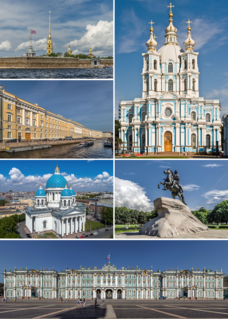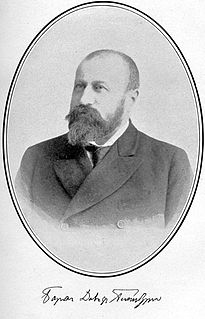Saint Petersburg State University is a Russian federal state-owned higher education institution based in Saint Petersburg. It is the oldest and one of the largest universities in Russia.

The Russian Academy of Arts in Saint Petersburg, informally known as the Saint Petersburg Academy of Arts, was founded in 1757 by the founder of the Imperial Moscow University Ivan Shuvalov under the name Academy of the Three Noblest Arts. Catherine the Great renamed it the Imperial Academy of Arts and commissioned a new building, completed 25 years later in 1789 by the Neva River. The academy promoted the neoclassical style and technique, and sent its promising students to European capitals for further study. Training at the academy was virtually required for artists to make successful careers.
The term Soviet Nonconformist Art refers to Soviet art produced in the former Soviet Union from 1953 to 1986 outside of the rubric of Socialist Realism. Other terms used to refer to this phenomenon are "underground art" or "unofficial art" (ru). Also, if to use the term "Russian avant-garde" in art, the "First wave of Russian avant-garde" was in 1910s-1930s, than this period in art is called the "Second wave of Russian avant-garde" (ru) (1960s-1980s).

Anton Alexandrovich Ivanov is a Russian lawyer, businessman, and official.
Alexander Alexeyevich Voznesensky was a Soviet economist, brother of Nikolai Voznesensky.
Herman Branover is a Russian Israeli physicist and Jewish educator. He is best known in the Jewish world as an author, translator, publisher, and educator. Branover is known in the scientific community as a pioneer in the field of magnetohydrodynamics (MHD). In his personal conduct he adheres to the customs and mystical philosophy of Chabad Hasidism.

Alexander Tikhonovich Pushnin was a Soviet, Russian painter, Doctor of Art-criticism, professor of the Repin Institute of Arts, lived and worked in Leningrad, member of the Leningrad Union of Artists, regarded as one of the representatives of the Leningrad school of painting, most famous for his portrait and historical painting.

Yuri Mikhailovich Neprintsev was a Soviet, later Russian, painter, graphic artist, art teacher, professor of the Repin Institute of Arts, People's Artist of USSR, and a member of the Academy of Arts of the USSR. He lived and worked in Leningrad and is regarded by art historian Sergei V. Ivanov as one of the brightest representatives of the Leningrad school of painting, most famous for his genre and battle paintings.

Piotr Petrovich Litvinsky was a Russian Soviet realist painter and art teacher, Honored Artist of the Russian Federation, who lived and worked in Saint Petersburg and Moscow. He was a member of the Saint Petersburg Union of Artists, and regarded as one of representatives of the Leningrad school of painting, most famous for his cityscapes and historical paintings.

Igor Petrovich Veselkin was a Russian Soviet realist painter, graphic artist, scenographer, stage designer, and art teacher, professor of the Repin Institute of Arts, who lived and worked in Saint Petersburg. He was a member of the Saint Petersburg Union of Artists, and regarded as one of the representatives of the Leningrad school of painting.

Piotr Petrovich Belousov was a Soviet, Russian painter, graphic artist, art teacher, professor of the Leningrad Institute of Painting, Sculpture and Architecture named after Ilya Repin, People's Artist of USSR, Corresponding member of the Academy of Arts of the USSR, who lived and worked in Leningrad. He was regarded as one of the brightest representatives of the Leningrad school of painting, being most famous for his portraits and historical paintings.

The Saint Petersburg Military Engineering-Technical University (Nikolaevsky), previously known as the Saint Petersburg Nikolaevsky Engineering Academy, was established in 1810 under Alexander I. The university is situated in the former barracks of the Cavalier-Guard Regiment where the university was founded.

Boris Sergeevich Ugarov was a Russian Soviet realist painter and art educator, Honored Artist of the RSFSR, who lived and worked in Leningrad. He was a member of the Leningrad Union of Artists regarded as one of the brightest representatives of the Leningrad school of painting.

Alexander Ivanovich Savinov was a Russian and Soviet painter and art educator who lived and worked in Saint Petersburg (Leningrad). He was a member of the Leningrad Union of Artists, regarded as one of the founders of the Leningrad School of painting.

The Leningrad School of Painting is a phenomenon that refers to a large group of painters who developed in Leningrad around the reformed Academy of Arts in 1930–1950 and was united by the Leningrad Union of Soviet Artists (1932–1991).
The year 1925 was marked by many events that left an imprint on the history of Soviet and Russian Fine Arts.
The year 1944 was marked by many events that left an imprint on the history of Soviet and Russian Fine Arts.
The year 1934 was marked by many events that left an imprint on the history of Soviet and Russian Fine Arts.
Saul M. Ginsburg was a Jewish-Belarusian American author, editor, and historian of Russian Jewry.


















